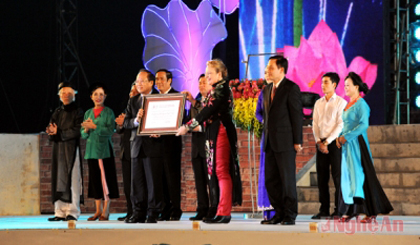UNESCO certificate honours Vi-Giam folk singing as intangible cultural heritage of humanity
A solemn ceremony was held in Vinh city, central Nghe An province on January 31 to receive the UNESCO certificate recognising the Nghe Tinh Vi-Giam folk singing as an intangible cultural heritage of humanity.
 |
| UNESCO Vietnam Chief Katherine Muller Marin presents UNESCO certificate honouring Vi-Giam to Minister Hoang Tuan Anh of Culture, Sports and Tourism. (Credit: VNA) |
Among the attendees were Chairman of the National Assembly (NA) Nguyen Sinh Hung, NA Vice Chairwoman Tong Thi Phong, NA Vice Chairman Uong Chu Luu, Deputy PMs Nguyen Xuan Phuc and Vu Duc Dam, UNESCO Chief Representative in Vietnam Katherine Muller Marin, and representatives from diplomatic agencies and international organisations in Vietnam.
UNESCO recognition of Vi-Giam folk singing was not only the pride of Nghe An and Ha Tinh people but also the shared happiness of people throughout the country, said Chairman of the Nghe An provincial People’s Committee Nguyen Xuan Duong, adding that the Nghe Tinh folk singing has now appeared on the world cultural map and officially become a part of the mankind’s cultural heritages.
The dossier on Vi-Giam folk singing to seek UNESCO’s recognition satisfied all the five criteria to become an intangible heritage of humanity and got appreciation from members of the Inter-governmental Committee for the Safeguarding of the Intangible Cultural Heritage, UNESCO Vietnam Chief Katherine Muller Marin affirmed.
Nghe Tinh Vi-Giam folk singing of Vietnam was officially recognised by UNESCO as an intangible cultural heritage of humanity at the 9th session of its Inter-governmental Committee for the Safeguarding of the Intangible Cultural Heritage in Paris on November 27, 2014.
This type of folk singing is popular in nearly 260 villages in the central provinces of Nghe An and Ha Tinh. The two provinces have about 100 singing clubs with over 800 vocalists, many of whom are actively preserving the folk music.
Vi-Giam folk music, estimated to have 15 tunes of Vi and 8 airs of Giam, is a repartee sung while working. It reflects the work, cultural life and feelings of the residents in the central coastal provinces.
Vi-Giam became the ninth Vietnamese cultural practice wining UNESCO’s intangible heritage status. The other eight practices recognised by UNESCO are Hue's royal court music, Gong space culture in Tay Nguyen (Central Highlands), the northern province of Bac Ninh's love duet singing, the Giong festival, Ca Tru ceremonial singing, Xoan singing, Don Ca Tai Tu music and the worship of Hung Kings.
(Source: nhandan.org.vn)
 về đầu trang
về đầu trang





